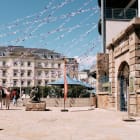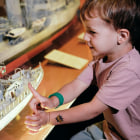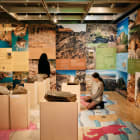
A short stroll through Town to discover some hidden gems of historic St Helier
Walk Details
- 30 Minutes
- Starts at: Beresford Street Kitchen
- Ends at: Beresford Street Kitchen
- 1 Mile
- Beginner
From the entrance of Beresford Street Kitchen turn right.
Walk a few paces and take the entrance on your right into the Fish Market. Beresford Market, now known as the Fish Market, was built in 1841 and has reduced in size compared to the original building. The market was named after William Beresford, the first Viscount of Jersey. The Beresford Street entrance is a great example of Victorian public architecture.
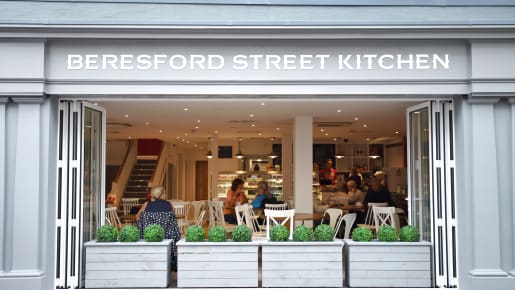
Beresford Street Kitchen
Walk through the Fish Market and exit on the far side, turning right.
Across the road stands Minden Place car park. This land was once owned by the Le Geyt family and was named in honour of William Le Geyt, Jersey’s first Postmaster, who fought in the Battle of Minden of 1759. The car park was built on the site of the Victorian Cattle Market. The pub to the right of the car park entrance is one of St Helier’s earliest hotel inns and dates from the late Georgian period.
Cross at the traffic lights to the corner of Minden Place and head north on Bath Street. Take the first left into Minden Street.
The music shop on the corner occupies an attractive Victorian building. Minden Street has a rare example of a 19th century warehouse on the left and the Salvation Army’s assembly rooms and citadel on the right.
The Salvation Army is a Christian church and charity that was founded in London in 1864 and continues to serve the community from these buildings today.
Walk to the end of the road and turn right onto Burrard Street. Take the second right into Halkett Place.
Walk past the Library and on the left there is stone plaque in the pavement outside number 101 Halkett Place where Florence Rowe was born. She married Jesse Boot, of Boots the Chemist, and in their retirement the couple made many gifts to the Island including the Glass Church, Coronation Park and FB Fields.
Walk towards Wesley Grove Methodist Church.
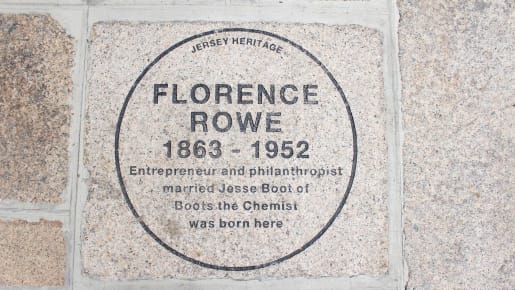
Memorial Plaque for Florence Rowe
Wesley Grove was built by the French speaking Methodists of St Helier and opened in 1847. They had been meeting since 1790 when Methodism was a relatively new religion to the Island. By 1838 there was a Methodist chapel in every parish and it became the most active religious movement in Jersey in the nineteenth century.
Walk through the small car park to the left of the Church and turn left onto Vauxhall Street. On the right you have an imposing pair of townhouses with the name Brussels Place inscribed on a pediment. St Helier expanded rapidly in the early 19th century and Brussels Place was one of the first buildings in this newly-laid out street on the outskirts of the Town. On the left you have some more modest 19th century houses retaining many original features.
At the end of the road you can see the Jersey Baptist Church.
Take the first left into Duhamel Place, The attractive terrace of houses on the right was built around 1840.
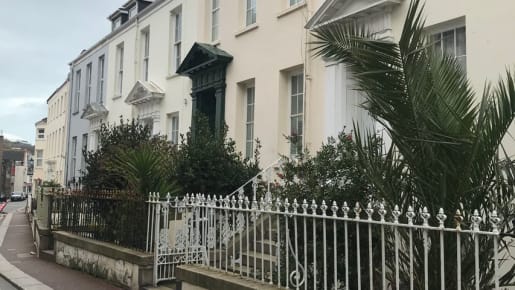
Duhamel Place
Take the first right into Duhamel Street and at the end of the road turn left onto New Street.
A short way down, on the opposite side of the road, is the 1937 Playhouse theatre, now converted into apartments. This site was originally a chapel and later became a social club associated with the Catholic church of St Thomas’s nearby. It was modernised in 1908 to include a cinema (possibly the first in Jersey) and the front was re-built in 1937 in the popular Art Deco style. The theatre opened in 1938 and was the home of the local repertory company the Denville Players until it closed in 1964.
At the junction turn left onto Burrard Street and then cross over into Don Street.

Playhouse Theatre
Take the first left onto Waterloo Street. On the left you will pass Waterloo Lane, a very narrow lane which still has an exposed historic cobbled surface.
At the end of Waterloo Street, carefully cross the main road and turn right.
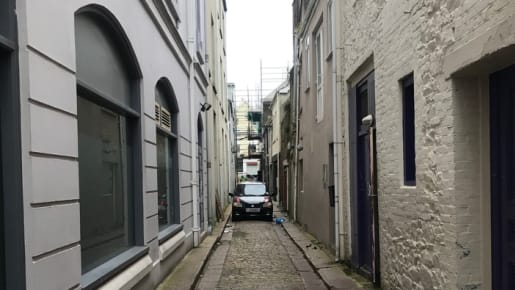
Waterloo Lane
Enter the Central Market via the first entrance on your left. This was built as the New Market in 1882, and is an outstanding example of a Victorian covered market with the most impressive cast iron architecture in Jersey. The entrances are decorated with intricate designs showing animals, fruit, and vegetables. At the centre of the market is an ornate and large fountain. A fine example of a Victorian post box can also be found within the Market.
Leave the Market by the opposite side from where you entered and walk down the attractive lane of shops before turning right to join Hilgrove Street.

Market gates
Hilgrove Street, with its historic cobbles, is more commonly known a s French Lane as it was where the Breton farmworkers, who came over to Jersey to work the potato harvest in the late 19th century, would gather in Town.
Turn left onto Hilgrove Street.
As you pass the rear of the Boots store, notice the Art Deco style of the building.
Continue to the very end of Hilgrove Street, ignoring the intersections with Bath Street and Hilary Street.
At the very end of the road it turns to the left and becomes Wesley Street, named after the impressive Wesley Chapel at the end of the
road. This was built in 1875 by the same architects as the Town Hall and the Royal Court, to replace the original Wesley Chapel of 1827 that had become unsafe. Following a fire in 2008, the façade was retained as part of this modern residential development.
Turn left onto Peter Street
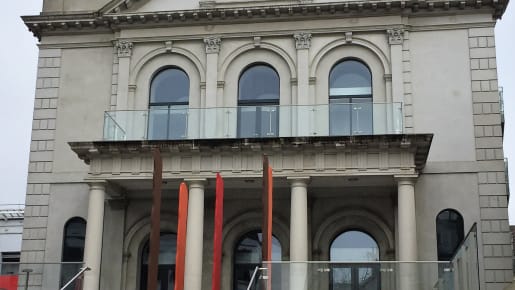
Wesley Chapel
On the corner is an early Victorian public house dating to 1846, originally called The Red Lamp. It stands on the corner of Ingouville Place and we know that a man called George Ingouville owned much of the property in this area in the 19th century. The streets in the vicinity of the pub – Ann Street, Charles Street, Hilary Street and Peter Street – are named after members of his family!
Continue along Peter Street to return to Beresford Street Kitchen for refreshments!

A Victorian Public House
Walk
The Yard Walk
Explore the history of St Helier with this guided walk which starts and ends at The Yard at Jersey Museum & Art Gallery.
Places to Visit
Jersey Museum, Art Gallery & Victorian House
In the heart of St Helier you’ll discover the story of Jersey - free entry.
Places to Visit
Maritime Museum and Occupation Tapestry Gallery
An interactive adventure about Jersey’s seafaring history and the Occupation Tapestry Gallery tells the Island’s story during WW2.
What's On
Jersey Island Geopark Visitor Centre
The free Visitor Centre will help you to understand and explore Jersey.











